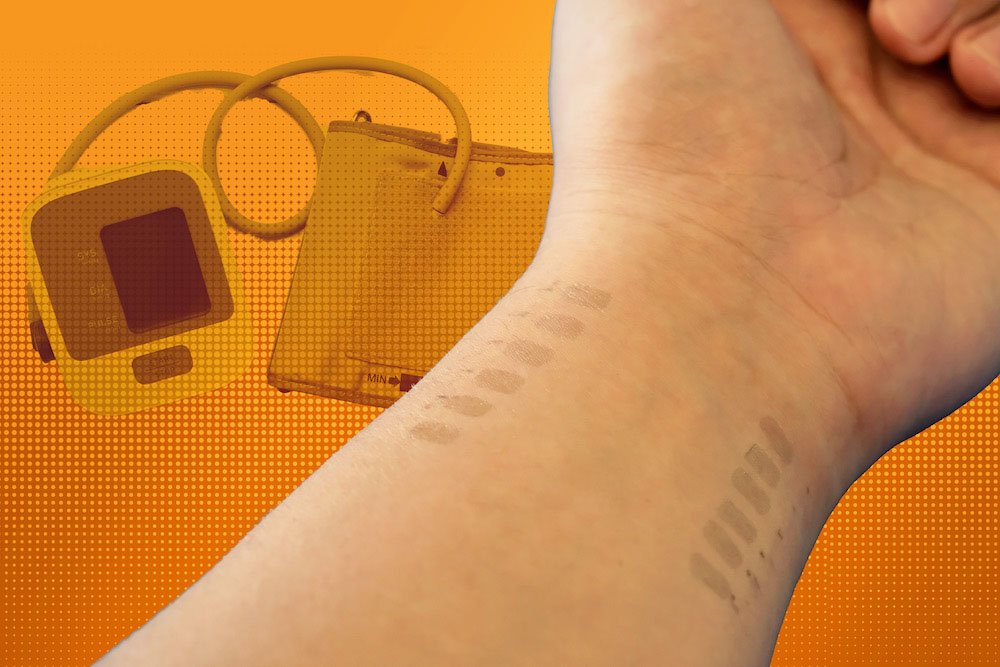| Jun 20, 2022 |
Electronic graphene tattoo promises continuous and mobile blood pressure monitoring
(Nanowerk News) Blood pressure is one of the most important indicators of heart health, but it’s tough to frequently and reliably measure outside of a clinical setting. For decades, cuff-based devices that constrict around the arm to give a reading have been the gold standard. But now, researchers at The University of Texas at Austin and Texas A&M University have developed an electronic tattoo that can be worn comfortably on the wrist for hours and deliver continuous blood pressure measurements at an accuracy level exceeding nearly all available options on the market today.
|
|
“Blood pressure is the most important vital sign you can measure, but the methods to do it outside of the clinic passively, without a cuff, are very limited,” said Deji Akinwande, a professor in the Department of Electrical and Computer Engineering at UT Austin and one of the co-leaders of the project, which is documented in a new paper published in Nature Nanotechnology ("Continuous cuffless monitoring of arterial blood pressure via graphene bioimpedance tattoos").
|
 |
| The continuous monitoring of the e-tattoo allows for blood pressure measurements in all kinds of situations: at times of high stress, while sleeping, exercising, etc. (Image: Cockrell School of Engineering)
|
|
High blood pressure can lead to serious heart conditions if left untreated. It can be hard to capture with a traditional blood pressure check because that only measures a moment in time, a single data point.
|
|
“Taking infrequent blood pressure measurements has many limitations, and it does not provide insight into exactly how our body is functioning,” said Roozbeh Jafari, a professor of biomedical engineering, computer science and electrical engineering at Texas A&M and the other co-leader of the project.
|
|
The continuous monitoring of the e-tattoo allows for blood pressure measurements in all kinds of situations: at times of high stress, while sleeping, exercising, etc. It can deliver thousands of measurements more than any device thus far.
|
|
Mobile health monitoring has taken major leaps in recent years, primarily due to technology such as smartwatches. These devices use metallic sensors that get readings based on LED light sources shined through the skin.
|
|
However, leading smartwatches are not yet ready for blood pressure monitoring. That’s because the watches slide around on the wrist and might be far from arteries, making it hard to deliver accurate readings. And the light-based measurements can falter in people with darker skin tones and/or larger wrists.
|
|
Graphene is one of the strongest and thinnest materials in existence, and it is a key ingredient in the e-tattoo. It is similar to graphite found in pencils, but the atoms are precisely arranged into thin layers.
|
|
E-tattoos make sense as a vehicle for mobile blood pressure monitoring because they reside in a sticky, stretchy material encasing the sensors that is comfortable to wear for long periods and does not slide around.
|
|
“The sensor for the tattoo is weightless and unobtrusive. You place it there. You don’t even see it, and it doesn’t move,” Jafari said. “You need the sensor to stay in the same place because if you happen to move it around, the measurements are going to be different.”
|
|
The device takes its measurements by shooting an electrical current into the skin and then analyzing the body’s response, which is known as bioimpedance. There is a correlation between bioimpedance and changes in blood pressure that has to do with blood volume changes. However, the correlation is not particularly obvious, so the team had to create a machine learning model to analyze the connection to get accurate blood pressure readings.
|
|
In medicine, cuff-less blood pressure monitoring is the “holy grail,” Jafari said, but there isn’t a viable solution on the market yet. It’s part of a larger push in medicine to use technology to untether patients from machines while collecting more data wherever they are, allowing them to go from room to room, clinic to clinic and still get personalized care.
|
|
“All this data can help create a digital twin to model the human body, to predict and show how it might react and respond to treatments over time,” Akinwande said.
|

